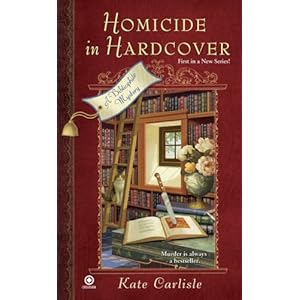Welcome to the new version of our blog! We just migrated over to WordPress, please adjust your bookmarks accordingly. We have a new URL, but we have set up a re-direct for the old one so you can still find us.
The holiday season is upon us, and is our tradition we offer up some last minute gifts for that hard-to-buy-for conservator or preservation enthusiast on your list. This year it’s all about fiction and movies sine we read enough technical literature for our jobs. All work and no play…
 Books
Books
Homicide in Hardcover: A Bibliophile Mystery by Kate Carlisle. The description reads, “The streets of San Francisco would be lined with hardcovers if rare book expert Brooklyn Wainwright had her way. And her mentor wouldn’t be lying in a pool of his own blood on the eve of a celebration for his latest book restoration.” Intriguing, no?
The Sixteen Pleasures by Robert Hellenga. Written in 1995, the book follows a young conservator on her journey to Florence to help with the recovery of books affected by the floods of 1966 (a seminal year in the history of library conservation theory and practice). Along the way our heroine discovers more than just a rare volume of erotica.
The Kill Artist by Daniel Silva. Part of the Gabriel Allon series, the main character is an Israeli intelligence operative who also happens to be a paintings conservator. Don’t you think some of your colleagues may be secret undercover agents with mad spy skills?
Movies
 National Treasure. What better way to represent conservators than one that is willing to squirt lemon juice on the U.S. Constitution in the name of discovering long lost treasure? And Nicholas Cage is just fun to watch, in my opinion.
National Treasure. What better way to represent conservators than one that is willing to squirt lemon juice on the U.S. Constitution in the name of discovering long lost treasure? And Nicholas Cage is just fun to watch, in my opinion.
Ghostbusters II. Admittedly not as good as the original but still a fun movie filled with ectoplasm and all around hijinks. Siguorney Weaver’s character, Dana Barrett, is a paintings conservator.
Holly Hunter also plays a paintings conservator in Home for the Holidays. Why do paintings conservators get all the character lines? Anyway, a light and funny film especially good for those of you traveling to meet family this year.
More
For more finds be sure to visit Conservation Online’s listing of books, movies and more, all with a conservation theme or character. If you have any to add, leave us a note.







 I love the new fiscal year, it’s like Christmas in July or September. We got our yearly order of pamphlet binders this week. What do two tons of binders look like? Like a big ol’ pile of presents waiting to be unwrapped.
I love the new fiscal year, it’s like Christmas in July or September. We got our yearly order of pamphlet binders this week. What do two tons of binders look like? Like a big ol’ pile of presents waiting to be unwrapped. Yes, I’m irrationally exuberant about supplies. I’m the same way with paste recipes and statistics, just ask anyone in the lab.
Yes, I’m irrationally exuberant about supplies. I’m the same way with paste recipes and statistics, just ask anyone in the lab. The Head of Acquisitions brought these over after they discovered the books were damaged during shipping. According to her, these would be very difficult to replace so she wanted us to save them if we could. As you can see, these got pretty squished, and the black smudge indicates maybe they got caught in some mechanical thing. They were very bent and had a lot of little page tears.
The Head of Acquisitions brought these over after they discovered the books were damaged during shipping. According to her, these would be very difficult to replace so she wanted us to save them if we could. As you can see, these got pretty squished, and the black smudge indicates maybe they got caught in some mechanical thing. They were very bent and had a lot of little page tears. I put them in the press for a very long time, giving the pages the opportunity to flatten out and stay that way. Then, as any good manager will do, I delegated the treatment to
I put them in the press for a very long time, giving the pages the opportunity to flatten out and stay that way. Then, as any good manager will do, I delegated the treatment to 
 Our group has been studying
Our group has been studying